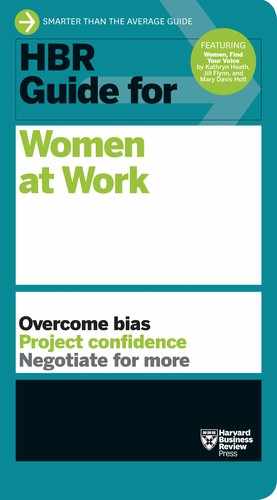CHAPTER 8
Three Ways Women Can Rethink Office Politics
by Kathryn Heath
Men and women don’t look at office politics and power dynamics the same way. That’s what my consulting partners and I found when we surveyed 134 senior executives in large organizations and conducted follow-up interviews with 44 of them. There’s no right or wrong here, but the discrepancies help explain why women assert themselves differently.
We found that men tend to talk about “competition” when they describe office politics, using language like “the tools people use to win at work,” whereas women are more likely to cast it as “a natural part of influencing” and emphasize the ability to shape “ideas and agendas.” Similarly, women and men report having different objectives in the political situations they face at work. Men use words like “achieving results,” and women—again and again—talk about “influencing others.”
Such differences are likely fueled in part by lingering double binds and gender biases in the workplace. In our study, 81% of women and 66% of men said that women are judged more harshly than men when they are seen as “engaging in corporate politics.” So women don’t want to be viewed as political—it undermines them. That may explain why 68% of women said they dislike office politics, even though they want to assert themselves at work—and why the majority of women in our interviews said they were more interested in “influence” than in pure power.
Like everything else, authentic influence takes practice: You train so you can transform. Here are a few strategies we’ve seen work for the women we’ve coached.
Create Relationship Maps
Step one is knowing which people to influence. Who has decision-making power in your organization? Who are the informal influencers? Who is most likely to resist your agenda because of competing objectives?
Creating a relationship map can help you sort all of this out. People in sales close deals by identifying deal advocates and blockers, often using complex software and customer databases to generate the relationship maps they need. For our purposes, the only prop required is a legal pad, a whiteboard, or a laptop. Your relationship map can look like an annotated org chart or a more complicated networking diagram. The key is to identify the stakeholders and influencers who can help you achieve your job and career goals. This visual exercise allows you to cultivate a deeper understanding of your network so you can build meaningful connections and secure allies to amplify your influence. Women are generally good at relationships (the Gallup survey “Women in America: Work and Life Well-Lived,” shows this), and they can use this strength to study their maps and build bridges to decision makers.
Construct a Scaffolding
We can scale our influence by adding multiple layers of support—not only the usual mentors and senior-level sponsors, but also “agents” and “truth tellers.”
Agents are people in your organization or industry with whom you are close. Ideally, they already appreciate and trust you enough to vouch for your talent and promote you to others. They don’t require as much effort to cultivate as mentors and sponsors (both of which we’ll discuss later in this section), but they require nurturing. Your very best agents proactively look for opportunities to help you by mentioning your name in key conversations and sharing intelligence.
Truth tellers are exactly what they sound like: the trusted allies who tell it like it is. They look you in the eye when you are up for a promotion and say, “If you don’t work at gaining more followership, you may miss your chance to move up.” Or, after a crucial presentation: “It went well, but next time make stronger eye contact, speak slowly, and use muscular language.”
Start your scaffolding with a small, manageable number of diverse advocates, and build it up over time.
Think Bigger
Finally, don’t doubt your ability to wield influence. Are systemic barriers still stacked against us? Yes. But accumulating influence requires big, bold ideas. So we coach women executives to think bigger, aim higher, and own their vision.
As one female executive told us: “I have made it my mission to show up with confidence and to be my true self. I have found that influence and authenticity are inextricably linked. Only by being truly self-confident can we influence others to follow us.”
__________
Kathryn Heath is a partner at Flynn Heath Holt Leadership, which specializes in leadership development programs and executive coaching for women. She is a coauthor of The Influence Effect: A New Path to Power for Women. Follow her on Twitter @FlynnHeathHolt.
Adapted from “3 Simple Ways for Women to Rethink Office Politics and Wield More Influence at Work” on hbr.org, December 18, 2017 (product #H042FL)
